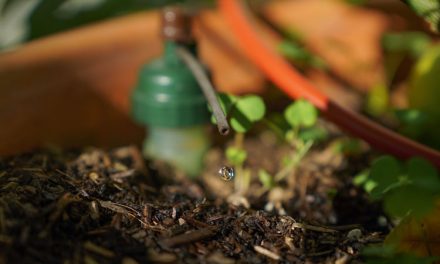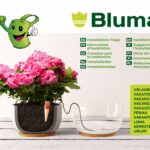Would your garden be better off using Blumat moisture sensors and distribution drippers, or using BluSoak drip tape instead of the distribution drippers? The devil’s in the details, and there are a number of factors that could and should influence your choice.
What do Distribution Drippers and Drip Tape do?
These two components of Blumat watering systems essentially do the same thing, but carry different advantages/disadvantages. Both of these components extend the watering ability of an individual Blumat sensor, making Blumat systems economical and commercially feasible. While the sensors were originally designed to emit directly into soil or other growing media, these components allow a single Blumat sensor to irrigate extended volumes of soil. For example, we can irrigate up to 120 square feet using just two Blumat sensors and drip tape! Using Blumat sensors alone, 120 square feet would be costly, tedious to maintain, and frankly unreasonable for the vast majority of gardeners.
Distribution drippers essentially turn the Blumat from a point of single emission into up to 5 points of emission (although we have customers who report using up to 30 drippers following a Blumat with success, we wouldn’t necessarily recommend it).
Drip tape lengths emit moisture from the Blumat evenly along a whole length. The tape can be coiled, put in “s” curves along a bed or soil surface, or otherwise configured to emit water exactly where the gardener needs it. It allows for even, uniform distribution of moisture or nutrient solution, and is a practical, easeful, and economic way to extend the watering ability of a Blumat sensor.
When do I use Blumat & Distribution Drippers?
As general rules of thumb, these are situations to use distribution drippers:
- Container volume is under 20-30 gallons
- Water supply is via gravity with limited elevation/pressure
- Small-scale, quality-focused gardens with a variety of species or cultivars
- Uneven, sloped garden landscapes
While there are exceptions, generally there should not be more than 5 drippers following a blumat sensor. Each distribution dripper adds a point of moisture distribution from a single blumat. Using drippers, a gardener could have a blumat emit at 5 distinct points in a container. This means that the “zone” that can be sensed and irrigated by a Blumat and up to 5 drippers cannot be too large. The largest square footage that we recommend for a blumat w/ 5x drippers is 4 square feet. Even this can be somewhat of a stretch.
If, for example, the gardener has a raised bed with many different species or strains, it could be advantageous to implement many of these different zones–one for each species or cultivar. If a gardener just has a few raised beds, this is a viable option to have a highly sensitive, high-performing Blumat system. Scaling this approach up however can be difficult. Each additional blumat sensor adds a point of sensitivity, maintenance, and potential failure. This means that adding blumat sensors to your system is a double-edged sword! It can be a great boon on a small scale, or an invitation for a headache on larger-scale systems.
When do I use Blumat & BluSoak Drip Tape?
As general rules of thumb, these are situations to use BluSoak drip tape:
- Container volume is over 20-30 gallons
- Garden beds or raised beds with relatively high square footage
- Water supply is via pressure/pump
- Commercially-oriented gardens
- Even/level garden landscapes
When a container is smaller than 20-30 gallons, using drip tape is actually more expensive than using drippers. However, that changes quickly as a garden scales up. A blumat can feed a length of tape roughly 20 feet long.That means we can sandwich lengths of drip tape about 40′ between two blumat sensors. Using a double manifold design, we can irrigate up to 120 square feet (6′ x 20′) in economically oriented designs!
For commerical farms/gardens and those with series of raised beds, using BluSoak drip tape is a no-brainer. It is economical, low maintenance, high performance, and the return on investment is the highest of any blumat watering system. Using drip tape with larger-scale gardens and large containers allows for the irrigation of huge areas using few blumat sensors. This does mean that these systems are less sensitive than dripper-based systems, but they’re significantly cheaper and easier to maintain, with minimal changes in performance.
Key Takeaways
- Both drippers and tape extend the watering abilities of Blumat sensors
- Blumat sensors add points of sensitivity (but also cost and maintenance), while drippers and drip tape add points of emission/distribution
- Drippers are generally good for smaller containers and smaller gardens
- Drip tape (aka “soaker hose”) is generally good for larger containers and larger gardens
- Tape-based systems can run into issues when pressure is limited
- Tape-based systems must be level




